Part One in new News-Press DUI series
By PETER LANCE SPECIAL TO THE NEWS-PRESS
October 3, 2012 6:23 AM
First of five parts
“It was the best of times, it was the worst of times.” That’s how Charles Dickens opened his epic novel of turmoil in England and France on the brink of revolution. In 1775 those two crime-ridden capitals couldn’t have been more different and yet more alike.
Today two cities exist in the state of California only 90 miles apart. Both are governed by identical drunken driving laws and yet their treatment of police officers suspected of committing the identical crimes of perjury and filing false statements couldn’t be more different. 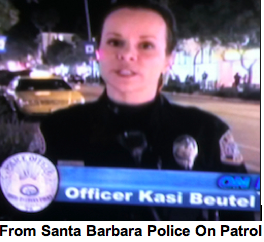
In each case, investigations were commenced when drivers, suspected by the police of driving under the influence were pulled over, subjected to field sobriety tests and then arrested. In each case, the charges were dropped as a result of police conduct. And in each case the arresting officer who filed the police report was a decorated DUI cop having won awards from Mothers Against Drunk Driving.
The difference is that in Los Angeles, LAPD officers Craig Allen and Phillip Walters are facing charges punishable by up to four years and eight months in state prison, while in Santa Barbara, as far as the public knows, Officer Kasi Beutel has never been suspended, cited or subjected to any misconduct proceedings.
She remains on the job and in uniform – and on Jan. 28, she was promoted to beat coordinator.
Further, she has received nothing but praise or support from the police chief and multiple officials including the District Attorney’s Office, three Superior Court judges, and the city attorney.
Still, the state Department of Insurance is considering evidence that Officer Beutel may have committed worker’s compensation fraud based on separate claims in 2009 and 2011, and a $12,000 study funded by the city into allegations of misconduct by Officer Beutel has been kept secret. So, in order to get some perspective into the findings that prompted the city to spend that money, those two contrasting DUI cases are worth studying.
THE PEOPLE V. THE DOCTOR
Just after midnight on Sept. 4, 2010, a 41-year-old medical doctor was driving west on York Boulevard, a busy street in the Eagle Rock section of Los Angeles near Occidental College, when she was pulled over by a Los Angeles Police Department motorcycle officer. Suggesting that she might be impaired, the officer, later identified by his radio code designation 43 Mary One, asked the doctor to step out of the blue Volkswagen Jetta she was driving and submit to a field sobriety test.
After she was arrested on suspicion of DUI, the doctor, insisting she was innocent, hired L.A.-based attorney Craig Sturm. In preparation for trial, Mr. Sturm ordered a copy of his client’s police report and right away, based on what she told him, he suspected that something was wrong.
“She told me that Officer Allen, who filed the police report and swore under penalty of perjury that he’d pulled her over with his partner Officer Walters, didn’t arrive until many minutes after the first officer (43 Mary One) was well into her FST,” says Mr. Sturm.
“That meant that neither of these officers who took credit for the stop and arrest and signed the report, had actually seen her driving.”
“That raised questions about the probable cause for the stop. But later at a DMV hearing, under oath Officer Walters swore that he was with Officer Allen on patrol that night and that they’d both pulled her over.”
At this point, as in most DUI cases, it was he said/she said, the word of someone arrested versus the sworn statements of award-winning police officers. But Mr. Sturm was suspicious. So he subpoenaed copies of the dispatch log and radio call recording from the minutes before the doctor was pulled over, through the course of her field sobriety test and arrest.
What he found proved to Mr. Sturm that Officer Allen perjured himself on the police report. But Mr. Sturm needed confirmation from the MADD award winner on the stand, so he filed notice in Los Angeles County Superior Court for what is known as a 1538.5 suppression hearing. 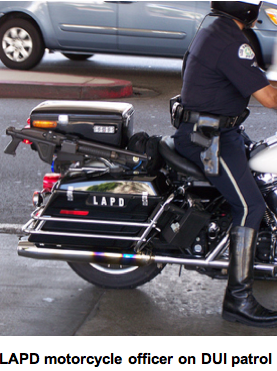
That hearing took place March 9, 2011, in Dept. 75 of L.A. County Superior Court before Judge Sally L. Meloch. In Los Angeles, criminal misdemeanors are prosecuted by the city attorney, so in this case the people were represented by Deputy City Attorney Joyce Uyeda.
Because of the stunning nature of the testimony, we’re producing portions of it verbatim. Officer Allen is a 12-year LAPD veteran who received MADD’s Century Award for making more than 100 DUI arrests in 2010. His direct examination by Ms. Uyeda begins with a description of his duties as an LAPD motorcycle officer:
Officer Allen: I ride a black and white police motorcycle for the exclusive purposes of traffic enforcement and DUI.
Ms. Uyeda: Were you on duty on Sept. 4, 2010, at approximately midnight or shortly thereafter?
Officer Allen: Yes. I was on York Boulevard approaching Avenue 52.
Ms. Uyeda: Who was your partner that day?
Officer Allen: Officer Walters.
Ms. Uyeda: What was your assignment at that date and time?
Officer Allen: We were assigned to an Emergency Operations Division … DUI enforcement and prevention (DEAP) task force.
Ms. Uyeda: Is there a reason why that task force exists?
Officer Allen: It is due to the number of traffic collisions within the city of L.A., the number of fatalities – because of DUI … and overall enforcement within that area which has a high DUI arrest rate.
Ms. Uyeda: And on that date and time did you notice anything unusual while you were on York and 52nd?
Officer Allen: I observed the defendant’s vehicle, which negotiated a right turn from York to northbound Avenue 52… York itself has numerous bars, tattoo shops other facilities in that area where a lot of people drink and come out of those bars intoxicated. So we saturate that area… We know that a lot of the vehicles use the cross streets behind York Boulevard. So we patrol the cross streets looking for possible DUI drivers.
Ms. Uyeda: Did anything catch your attention?
Officer Allen: (As) we made the turn to northbound Avenue 52 from York, I did observe the defendant’s vehicle – the blue Volkswagen Jetta – failed to stop at the white limit line and posted stop sign at Meridian (Street) on Avenue 52.
Ms. Uyeda: Did she make a complete stop?
Officer Allen: She slowed, but she failed to make a complete stop and she rolled through the stop sign at approximately 10 mph … I began to start my traffic stop for that original violation and then she failed to stop at a second stop sign and white limit line which was at Stratford (Road) doing the same thing, about 10 mph through the white limit line and clearly posted stop sign.
Ms. Uyeda: What happened after you saw the second violation?
Officer Allen: I had my lights on trying to initiate a traffic stop. The defendant’s vehicle made a left-hand turn to what would be westbound Ridgeview where she did stop on the north curb there.
Ms. Uyeda: OK, and officer do you see the individual whose car you pulled over, in court today?
Officer Allen: Yes, I do.
Ms. Uyeda: And could you please describe that individual?
Officer Allen: It’s the female sitting here to my right with the black long-sleeved shirt or dress.
Ms. Uyeda: Thank you. Your Honor, may the record reflect that Officer Allen has, in fact, identified the defendant?
The Court: The record will reflect that the Officer has identified the defendant.
Ms. Uyeda: Thank you. Officer Allen, what happened after you stopped her vehicle?
Officer Allen: I made approach on the driver’s side door and window, made contact with the defendant … As I was explaining the reason for the traffic stop to her, I immediately detected the order of an alcoholic beverage emitting from her breath. I did notice that her eyes were bloodshot and watery.
As we’ll see in re-examining the case of the People v. Michael Kenny, Officer Kasi Beutel used virtually identical language in the report pertaining to his stop: “I immediately noticed a smell of alcoholic intoxicant coming from his person; his eyes were bloodshot and watery. I asked him if he had any alcohol tonight, he stated no.”
According to ex-San Bernardino police sergeant Felix D’Amico, a 33-year veteran who observed more than 5,000 DUI arrests in his career, this is boilerplate language. But it can be subject to abuse.
“This is the only area of criminal law,” says Mr. D’Amico, “where an officer in the field can make three assertions and arrest you on the spot in the absence of any other independent proof: first, ‘I smelled the odor of alcohol;’ second, ‘The driver’s speech was slurred or deliberate;’ and third, ‘Their eyes were bloodshot and or watery.’ ”
Getting back to Ms. Uyeda’s questioning of Officer Allen:
Ms. Uyeda: At that time when you made those observations, what did you do next?
Officer Allen: I asked her if she had anything to drink, at which time she stated no and I had her exit the vehicle.
At that point in the proceedings, Officer Allen described in detail a series of field sobriety tests he said he’d administered to the doctor, including the horizontal gaze nystagmus test, the Romberg balance test and the “walk and turn” test, which he insisted she failed. Deputy City Attorney Uyeda then asked the officer what he did after administering those tests:
Officer Allen: Based on her failure to stop at the first stop sign at Meridian, based on her failing to stop at the second stop sign at Stratford, the odor of alcoholic beverage emitted from her breath upon contact with her, the bloodshot, watery eyes and observations based on the field sobriety tests, I placed her under arrest for DUI.
During cross-examination, defense attorney Mr. Sturm asked Officer Allen how many DUI arrests he’d made in his career.
Officer Allen: Hundreds.
Mr. Sturm: 500, more or less?
Officer Allen: Probably 500 or less.
Mr. Sturm: Now when did you write the arrest report in this case?
Officer Allen: That morning. Sept. 4.
According to Mr. Sturm, the police report, which mirrored Officer Allen’s testimony about the probable cause for the stop and his field sobriety tests, was signed by him under penalty of perjury. Officer Allen’s partner that night, Officer Walters, signed the accompanying DS-367 DMV form that Mr. Sturm says contained a verbatim copy of the probable cause for the stop from Officer Allen’s report.
That form too was signed under oath as to its truthfulness. It was at this point in the proceedings that Mr. Sturm lowered the boom, introducing into evidence what’s known as a daily field activity report incident recall log indicating the precise times that the various officers involved in the doctor stop and arrest responded.
On the night of Sept. 4, Officer Allen’s ID was 43 Mary Four. Officer Walters’ was 43 Mary Three – and the unnamed officer who first responded was 43 Mary One. Lawyer Mr. Sturm handed Officer Allen the recall log and asked him to read it.
Mr. Sturm: Excuse me. (reading) “12:20. P.O. 43 M One. Location Ridgeview (and) Avenue 52.”
Officer Allen: OK.
Mr. Sturm: (43 Mary One) That’s not you, right?
Officer Allen: No.
Mr. Sturm: You are not 43 Mary One, right?
Officer Allen: No.
Mr. Sturm: Now, do you see… That says 12:20. Right?
Officer Allen: Yes.
Mr. Sturm: You indicated that you pulled my client over at 12:10, right?
Officer Allen: Approximately.
Mr. Sturm: Now, if we go down (to) 12:23 – see that? 43 Mary Four en-route to Ridgeview and Avenue 52.
Officer Allen: OK.
Mr. Sturm: That shows you en-route, correct?
Officer Allen: Correct.
Mr. Sturm: After 43 Mary One already pulled my client over right?
Officer Allen: No. I was the one that pulled the client over.
Mr. Sturm: OK. Do you see at 12:35 it shows you – 43 Mary Four – arrived at scene. Do you see that on the log?
Officer Allen: Yes, I do.
Mr. Sturm: OK. Now, are you sure officer, it’s your testimony that you pulled my client over?
Officer Allen: I pulled her over.
Mr. Sturm: Even though this log is saying you didn’t.
Officer Allen: I pulled her over.
Mr. Sturm: You were 43 Mary Four that night correct?
Officer Allen: Correct.
With Officer Allen insisting that he’d made the stop, in defiance of the incident recall log, the defense attorney entered the dispatch tape into evidence. When it was played in open court, it was clear that Officer Allen had not responded to the stop until 12:35 a.m., 25 minutes after he said he’d pulled the doctor over – a stop that had clearly been effected by the officer designated 43 Mary One.
Finally, confronted with the incontrovertible audio evidence, Officer Allen admitted the truth.
Mr. Sturm: You never saw my client drive, did you?
Officer Allen: (barely audible) No I did not.
Mr. Sturm: Excuse me?
Officer Allen: No I did not.
Mr. Sturm: So this whole time you were lying? (no response) Do I need to go further?
Ms. Uyeda: No.
According to Mr. Sturm, there was a look of total shock on the prosecutor’s face. She had no idea that her main witness was prepared to lie to get a conviction.
Ms. Uyeda asked for a short recess. When the hearing resumed, she moved to dismiss the case.
THE D.A. MOVES INTO ACTION
Confronted with the evidence that two decorated LAPD DUI officers lied in a police report and each of them lied under oath at separate hearings, Deputy District Attorney Renee Chang of the L.A. County D.A.’s Justice System Integrity Division commenced an investigation.
“She contacted me right away” says Mr. Sturm, “and she has been incredibly diligent in following up. You have to appreciate that particularly in a DUI case the word of the arresting officer who purports to perform the field sobriety tests is almost the entire case. I can’t for the life of me understand why these two cops lied and jeopardized their careers for a misdemeanor collar.”
After surrendering on July 25, with bail set for each at $45,000, officers Allen and Walters were released on their own recognizance. They pled not guilty at their arraignment on Aug. 10. A preliminary hearing for both officers was set for Oct. 10.
Neither Ms. Chang, the deputy district attorney, nor Ms. Uyeda, the deputy city attorney, would comment on the investigation. But the case was considered so significant that the Los Angeles County District Attorney’s Office issued a press release and the story was covered by the Los Angeles Times in a July 25 piece under the headline: “2 LAPD officers lied about making DUI arrest, prosecutor says.”
Getting out in front of the scandal, LAPD Chief Charlie Beck issued the following statement: “The Los Angeles Police Department holds our officers to the highest standards of integrity and professionalism. Upon being notified of the allegations against our officers, the LAPD launched an internal investigation. 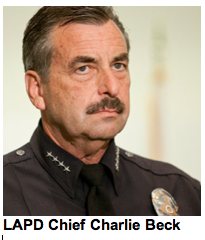
“Both officers were immediately removed from the field and given administrative assignments. As the internal and criminal investigations progressed, both officers were assigned home pending the outcome of the internal investigation. I am truly saddened by the events that led to the perjury charges pending against two of my officers.
“The character of our organization is defined by the conduct that we condone. These actions were entirely unacceptable.” The official statement added that “pursuant to the internal LAPD investigation, one officer has been fired and the other is facing termination at an administrative hearing.”
THE PEOPLE V. PETER LANCE
The LAPD case and its aftermath had many things in common with my own arrest by Officer Beutel on Jan. 1, 2011. She was a two-time MADD award winner then coming to the close of her tenure as lead officer in the Santa Barbara Police Department’s Drinking Driver Team, a dedicated unit like the LAPD’s DEAP project charged with DUI suppression.
The charges in my case were dismissed Nov. 15, 2011, after Santa Barbara County Superior Court Judge Brian Hill ruled that the two officers who pulled me over, Bruno Peterson and Heather Clark, lacked probable cause for the stop.
It was shown in court and multiple Department of Motor Vehicles hearings that Officer Beutel filed a false DMV DS-367 report, under penalty of perjury, in which she claimed I’d been stopped for making “unsafe turning movements;” something she could not have known because, like officers Allen and Walters she wasn’t present for the stop.
But the probative evidence of misconduct by the former Kasi Moore didn’t end there. In a series that was published in the News-Press in 2011, I presented information on how she may have committed bankruptcy fraud in 2000; that she’d perjured herself during divorce proceedings in 2005; and that she’d suborned the perjury of the minister who married her in 1999 by asking him to back-date her marriage license so that she might receive more post-divorce support.
Since “lack of well balanced credit” is one reason for an applicant’s rejection by the Santa Barbara Police Department, Officer Beutel’s troubled credit history was relevant to the question of whether department brass took her Chapter 7 filing into consideration when she was sworn in as a peace officer Nov. 28, 2005.
The series presented evidence suggesting that by January 2011, when she was coming to the end of a two-year term as lead officer in the DDT and closing in on her second “Top DUI Officer” award from MADD, Officer Beutel had committed multiple acts of misconduct including filing false information on multiple police reports, committing perjury on at least one form filed with the DMV, withholding exculpatory evidence from DUI suspects and witnessing as many as five Trombetta blood test waivers – the “Miranda warnings” of DUI investigations – in which the signatures of suspects had been forged.
USING PRE-CHECKED DUI FORMS
The series showed how Officer Beutel went into the field in 2009 and 2010 with DUI forms in which she’d pre-checked up to half the boxes – before any contact with the people being investigated – evidence indicating a pre-determined mind-set to frame innocent drivers. 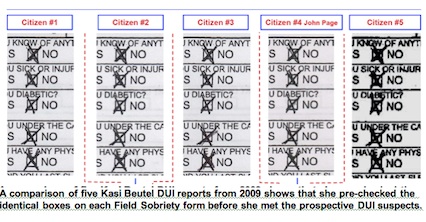
She’d also been the beneficiary of at least three claims for alleged work-related injuries between November 2007 and August 2011, alleging in one case that she sustained a “shoulder injury” from a DUI suspect she’d Tasered when the police report from that incident stated that she was “not injured. The Fraud Division of the state Department of Insurance is investigating the incidents.
THE STOP AND ARREST on NEW YEAR’S DAY
Last year’s series commenced when I noticed that Officer Beutel had blocked the exit port of the Alcotest 7410 breathalyzer she had used to allege that I had a blood alcohol content of .09 – or one hundredth of one per cent over the legal limit.
After finding that a Trombetta blood test waiver that I never signed was inserted into my police report and discovering that the state attorney general had issued a directive to police agencies not to block the 7410 exit port because it could boost BAC levels, I wondered if there were others like me.
To that end, I ran a series of newspaper ads and found more than a dozen other people arrested on suspicion of DUI by Officer Beutel – five of whom swore that their signature on Trombetta waivers had been forged and others with extraordinary stories of abuse including Michael Kenny, a local fisherman who was Tasered by Officer Beutel during a DUI stop only to discover (post blood test) that his blood alcohol content was .07 – below the legal limit.
STARTING TO KICK OVER ROCKS
Once I was fully exonerated and beyond the criticism that had come from some media quarters that I had a conflict of interest, I decided to revisit what News-Press editorial columnist Terry Tyler dubbed “Kasi-gate.”
As a veteran investigative reporter I’ve written three books for HarperCollins documenting the counterterrorism failures of the FBI on the road to 9/11 and beyond. In my first book, “1000 Years for Revenge,” and my latest, “Triple Cross,” I helped connect the dots by creating detailed illustrated time lines. The most recent one can be accessed here: 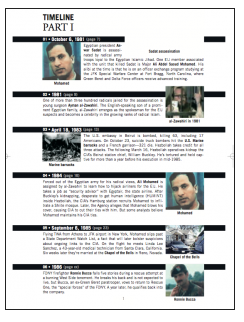
The benefit of a week-by-week, month-by-month approach to investigative reporting is that it offers the reader perspective. It’s difficult to assess the equities in any given news story when one is in the middle of it. So after the DMV returned my license in March, I decided once again to begin kicking over rocks. I went back and compiled what has now become a research file of more than 20 volumes running more than 10,000 pages.
The files include all of the court and DMV proceedings in the People v. Peter Lance as well as hundreds of other transcript pages from related trials and police reports linked to Kasi Beutel, her husband, Mark Corbett, who proceeded her on the Santa Barbara Police Department Drinking Driver Team and her successor Aaron Tudor, who gained notoriety on Oct. 21, 2011, after his video recorded stop, arrest and Tasering of DUI suspect Tony DeNunzio in a parking lot off Las Positas Road.
The only reason there was any video of that incident is that Officer Tudor’s unit was equipped with an on-board video system that was installed as a direct result of my original 13-part series in the News-Press. 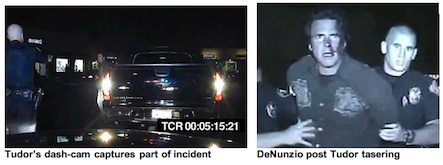
In Part Five I documented how the Santa Barbara and Guadalupe police departments were the only major law enforcement agencies in the county without video in all patrol units.
As a result, the Santa Barbara County Grand Jury commenced an investigation in July 2011 and issued a report recommending that the “police departments in Santa Barbara and Guadalupe install current audio-visual technology for all of their patrol vehicles.”
By Sept. 14, 2011, Santa Barbara Mayor Helene Schneider disclosed that the city was studying the budget implications of installing such video in SBPD units. Later in this series we’ll report on just how well the SBPD has complied.
HEROIN AND THE DUI SUSPECT
Beginning Thursday and over the next four days, the News-Press will re-examine some of the allegation against Office Beutel. We’ll offer new evidence that suggests Kasi Beutel engaged in worker’s compensation insurance fraud.
Most troubling of all, we’ll provide shocking evidence, including jail video images, that she filed a false report on a woman being booked on a DUI allegations inside County Jail and a bindle of heroin that inexplicably showed up near the woman’s feet – an incident that resulted in Officer Beutel urging the Santa Barbara County District Attorney’s Office to prosecute the woman for bringing a controlled substance into the jail.
The suspect – a single mother of a 9-year-old boy, whose brother was a law enforcement officer killed in the line of duty in 2009 – lost her job as an insurance broker following charges filed by the Santa Barbara County District Attorney’s Office that she was in possession of black tar heroin at the time of her booking.
The charges were later dropped after video from the jail raised serious questions about Office Beutel’s account of the incident. Our investigation will show that Kasi Beutel filed a false narrative on the alleged drug possession. 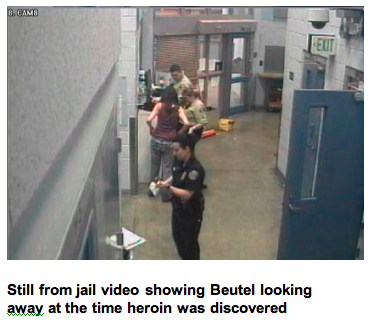
While guilty of a DUI, the woman passed a polygraph examination in which she swore she never brought drugs into the jail. She’s also taken multiple blood and DNA tests proving that at the time of her arrest and up to three months prior, she had zero heroin or opiates in her system.
EDITOR’S NOTE: Reporting for this series, like that for Peter Lance’s original series on Santa Barbara Police Department Officer Kasi Beutel last year, involved repeated requests to city officials for comment on and the release of a review of the officer’s conduct. But the stance of the city has been to withhold information and comment based on the legal theory of a threat of a lawsuit by Mr. Lance, as well as state law prohibiting the release of personnel documents. Copyright 2012 By Peter Lance



Recent Comments